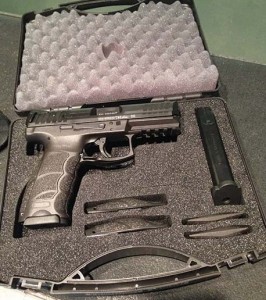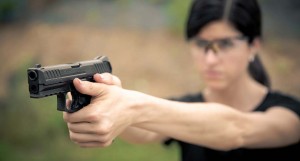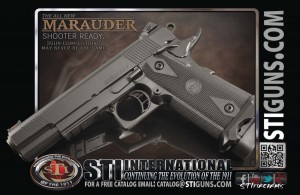by Miko Tempski
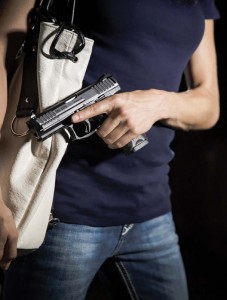 Thirty-odd years have passed since the modern generation of striker-fired pistols first revolutionized the police and defensive handgun markets. Heckler & Koch (HK) was heavily involved in early striker-fired pistol development, with the VP70 and then the awesome P7 line. If you have never experienced the joy of a P7, I highly recommend you go out and borrow one from a friend. In my experience, they are among the most accurate pistols out there, and they are a blast to shoot.
Thirty-odd years have passed since the modern generation of striker-fired pistols first revolutionized the police and defensive handgun markets. Heckler & Koch (HK) was heavily involved in early striker-fired pistol development, with the VP70 and then the awesome P7 line. If you have never experienced the joy of a P7, I highly recommend you go out and borrow one from a friend. In my experience, they are among the most accurate pistols out there, and they are a blast to shoot.
Nonetheless, in the 1980s the P7 lost its place among the top of the striker-fired pistol market to lightweight, higher capacity and more cost-effective polymer-framed options like the Glock, which quickly took over the lion’s share of the law enforcement market and large portions of the civilian defensive market as well.
Manufacturer’s Specs:
Dimensions
Overall length 7.34 in.
Overall height 5.41 in.
Overall width 1.32 in.
Barrel length 4.09 in.
Sight radius 6.38 in.
Weight (empty mag) 25.56 oz.
Other Specifications
Magazine capacity 15 rounds
Trigger system Striker fired
Trigger pull (N) 5.4 lbs.
Trigger travel .24 inches
Return travel .12 inches
Sights three dot,
non-radioactive luminous
Barrel Profile/Twist—
Polygonal, 6 grooves, right-hand
twist, 1 in 9.8 inches
As these markets evolved, numerous companies launched themselves into what has become a sub-market dominated by polymer striker-fired defensive pistols, with varying levels of success. Despite predictions of overthrow, none has truly unseated the Glock. Instead the market has offered varying success to each of the new arrivals, creating a whole category of the handgun market, which now offers striker-fired polymer framed handguns in many flavors. It is into this market segment that HK has thrust the new VP9 and I predict the VP9 will quickly rise to join the top performers.
The VP9’s early reviews are justifiably stellar. I had just begun to read the first reviews of this fine pistol when I got a chance to put my own hands on one. It came to me in a handsome and utilitarian black clamshell case, with a pair of 15-round, 9mm x 19 magazines, an assortment of changeable backstraps and side panels, a spent casing, a lock and the manual.
As I grabbed the pistol, I was immediately pleased by the incredibly well-designed ergonomics. Like the HK P30, the VP9 was truly designed to fit the hand. It instantly feels like a natural extension of your arm, and you really do not want to set it down. While the original configuration fit my hand perfectly, the variety of fits provided by the three changeable backstraps and six side panels is likely to make this a comfortable pistol for just about anyone. The VP9 is very similar in size and weight to the P30, and fits somewhere between the full and compact sized models offered by its competitors.
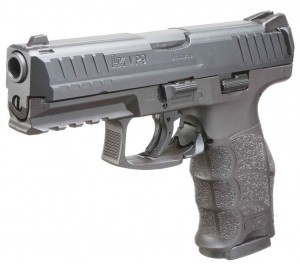
The VP9 is one of the few striker-fired pistols that is also a looker. It is designed to be a modern combat firearm, ready for your light or laser. The finger grooves and ergonomic design make it among the most comfortable guns on the market.
I was particularly gratified by what feels like a lowered bore axis compared to other late model HK pistols I have gotten the pleasure to shoot. When pointing the VP9 on target, I felt more like I was handling the P7 than a USP or the newer P30. Considering the P7’s legendarily low bore axis, this was definitely a good thing. I am not sure how HK accomplished this feeling, because when I compared the VP9 and P30 side-by-side, the pistols’ grips looked remarkably similar. Perhaps a minor alteration to the depth of the beavertail cut was all it took. Maybe it was something else entirely. Either way, the lower bore axis feeling was quite welcome. It instantly made the gun feel right when pointed in on target and it would also pay dividends later, at the range.
Continuing to handle the gun in my office, I noted that all the controls were already set-up to be ambidextrous. The long slide release lever could be activated from either side of the slide. Similarly, the HK-style magazine release levers were found on either side of the base of the trigger guard. The only thing I found slightly perplexing about the design was HK’s addition of two new “charging supports” on the rear of the slide, near the standard cocking serrations. These supports are small polymer additions to the cocking serrations that are intended to provide the pistol’s operator “better gripping leverage for racking the slide rearward.” Personally, I found them unnecessary, but also unobtrusive. Perhaps they would aid a small-statured or small-handed shooter in getting a good grip while racking the slide. Luckily for anyone who does not like them, I am told they are removable.
Finally, I moved on to some dry fire practice and discovered what is likely, and rightfully, the most talked about feature of the VP9—its splendid trigger. It is as close to a true single-action trigger as I have felt on a modern striker fired pistol. The take-up is nearly negligible in both weight and length compared to other striker-fired pistols I have experienced. Once the limited slack is taken up, the trigger breaks very crisply, without much over travel after the break. Once the action cycles, the shooter must move their finger forward slightly to allow the trigger to reset. This is slightly different than my experience with other striker-fired pistols which feel like they have more pressure from the trigger pushing the trigger finger forward for the reset. The reset on the VP9 is nice and distinct, and can be clearly felt and heard. The trigger is the true star of this pistol.
Having examined the pistol as thoroughly as I could in the office, I excitedly packed it up and headed to the range. I also called a friend to join me, asking him to bring along his heavily used HK P30 for a comparison. Like me, he was instantly pleased when he picked up the VP9 and plans on adding it to his collection in the near future. Holding both guns in my hand, the VP9 still felt like it had a lower bore axis and pointed in slightly better.
We took turns firing a broad range of drills through the VP9. At close range, in rapid fire, the pistol performed well. There was very little muzzle-flip. That, combined with the trigger’s lack of over travel and short reset, made finding the front sight and squeezing off subsequent shots a quick and accurate affair. The experience was the same at ten yards, where we shot consistently tight groups. One of the range safety officers came over and admired the pistol. We offered him a chance to shoot and were impressed to see him shoot a two-inch group of ten rounds at ten yards in just five or six seconds. When we took the pistol out to 25 yards, its performance was similarly impressive. All rounds consistently hit their target. We declined to try any bench rested or otherwise supported shooting, as this is a defensive pistol and it was clearly more accurate than we were anyway.
As I began to work through some reloads, I noticed that at times my thumb was resting on the slide release lever, causing the slide to continue forward after the last round. Were I to carry this pistol, I would need to either train and adjust my grip slightly, or locate a lower profile slide release lever. Personally, I would have no issue making the lever flat, as I prefer to rack the slide during reloads rather than using the lever anyway.
The only other upgrade or addition I would seriously consider on the VP9 would be a set of tritium night sights. I like the “non-radioactive luminous” sights the HK comes with, but I worry that I will end up drawing my pistol and have bright rear sights with a dark front sight because a holster covers the front sight and blocks its access to light. I must admit that this is merely speculation, as I did not have a chance to do any low-light shooting with the VP9. Either way, the luminous sights are plainly a step above the plain painted plastic sights offered on competing pistols.
We did not experience any malfunctions during our testing of various types of ammunition. I have no reason to believe the VP9 will be any less reliable than other modern HK pistols, which already set the high bar for reliability in all environments.
Finally, in weighing whether or not to purchase this lovely pistol for myself, I was quite pleasantly surprised to discover its MSRP. At $719, it’s over $300 more affordable than the P30 that was launched a few years ago. You are telling me I can get HK reliability and style combined with a hard-to-beat trigger system for significantly less than some of the competition? I say, “Yes, please!” and I suspect so will many other gunowners.
Now, if we could only convince HK to sell us some of the more fun toys that Oberndorf produces. I think I need a nice MP5, MP7 or UMP to go with my VP9. Don’t you?
For more information, see an HK dealer, visit them online at: hk-usa.com, or phone: 706-568-1906.

